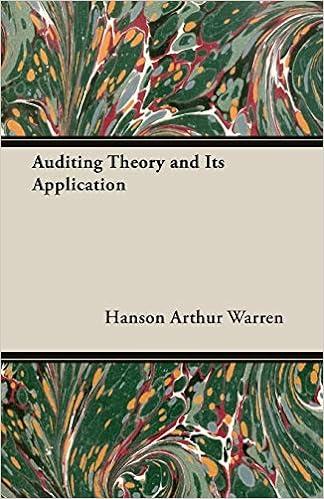Question
Assume you work as an accounting manager for a company that makes a mechanical component used to manufacture industrial machines. Your company manufactures these components
Assume you work as an accounting manager for a company that makes a mechanical component used to manufacture industrial machines. Your company manufactures these components in batch runs after customer orders have been received, and as a result the company has minimal finished goods inventory. Minimum order quantities are 800 units and maximum batch size is 2,200 units. Orders for more than 2,200 units are produced with multiple batch runs. Each individual component is imprinted with a unique serial number. Your company's business strategy is to differentiate their product as being among the most well-built and reliable mass production component available. Company products are rarely found to be defective and the company has one of the lowest sales return rates in the industry. Management pays close attention to quality control procedures performed on a batch-by-batch basis. During every batch run Quality Control (QC) department personnel pull a portion of the components from work in process for inspection and testing. These quality control procedures occur at three different stages of the production process. First, after the housing of a component have been assembled but before the mechanical and electrical "guts" of the component have been installed QC visually inspects 8% of the components in the batch run for visible flaws. Second, after the mechanical components have been installed, QC inspects 6% of the partially completed components and tests the mechanical parts through manual manipulation. Finally, after the assembly process has been completed, QC tests 4% of the finished products to ensure the component functions properly and performs within tolerance limits guaranteed by the company for every component they sell. The company offers a one-year warranty on every component they sell. Management estimates warranty expense for the current year based on actual warranty costs paid during the previous year adjusted for direct labor budget variances experienced during the current year. They calculate this estimate in three stages. Revised Spring, 2021 Case Study for Module 8 Page 2 of 6 First, management calculates actual warranty cost per unit for the previous year (in dollars) by dividing total warranty costs paid during the previous year by number of units sold during the previous year. Second, they determine the increase or decrease in direct labor budget variance per unit (in dollars) from last year to this year. Finally, management determines a warranty expense estimate per unit for the current year by adding (subtracting) any increase (decrease) in labor variance per unit for the current year to the actual warranty cost per unit paid during the current year. Management calculates and records warranty expense for the current year as number of units sold multiplied by warranty expense estimate per unit. Your company's independent auditor has challenged the validity of these warranty cost estimates. You decide to use analytics for gathering evidence about associations between actual Warranty costs, budget variances and warranty expense estimates. The procedure that management uses to estimate warranty expense is based on the assertion that warranty costs increase when labor budget variances increase. If so, then labor budget variances should increase when defect rates detected by QC inspections increase. You begin your analyses by constructing a data model to test for an association between labor budget variances and defect rates detected by QC inspections to provide evidence that management's assertion is valid. Your data model will be Budget Variance (LV) - Defect Rate (DR). Your data provides a record for every batch run during the past 12 years that includes the following attributes: Attribute Description Measure BN Manufacturing batch number (unique for each run) alphanumeric BV Labor budget variance for the batch run percent LH Labor hours incurred during the batch run number Q1 Defect rate for first QC inspection during batch run percent Q2 Defect rate for second QC inspection during batch run percent Q3 Defect rate for final QC inspection during batch run percent UP Units produced during batch run number Your data also provides a record for every unit manufactured during the past 12 years that includes the following attributes: Attribute Description Measure BN Manufacturing batch number (unique for each run) alphanumeric UV Labor budget variance allocated to the unit percent $8992 Revised Spring, 2021 Case Study for Module 8 Page 3 of 6 numeric WC Q1 Defect rate for first QC inspection during the batch run percent Q2 Defect rate for second QC inspection during the batch run percent Q3 Defect rate for final QC inspection during the batch run percent SN Serial number (unique for each unit) Warranty cost paid for unit (if any) dollars You have data about defect rates and labor variances both for batch runs and for individual units so you could build a data model to test either batches or individual units. You believe that the statistical method you use to test your model will produce reliable results. However, your question involves attributes that vary by batch but will be the same for all units produced during a batch. You are concerned that a model for associations among individual units may not be as valid as a model for associations among batch runs. Question 1: What type of model validity will be compromised IP LV - DR is tested with data for individual units instead of data for batch runs? You decide to use model data for batch runs. You consider proxies for LV and DR and decide that BV should be an appropriate proxy for LV.
Step by Step Solution
There are 3 Steps involved in it
Step: 1

Get Instant Access to Expert-Tailored Solutions
See step-by-step solutions with expert insights and AI powered tools for academic success
Step: 2

Step: 3

Ace Your Homework with AI
Get the answers you need in no time with our AI-driven, step-by-step assistance
Get Started


